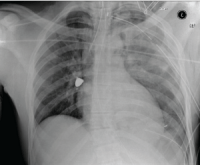-
Analyzing recent research on causes of gun violence
In 2015, over 36,000 people died from gunfire in the United States, according to the Centers for Disease Control and Prevention, with roughly two-thirds of those deaths being classified as suicide. America’s gun-murder rate is 25 times that of the other high-income nations, and the gun-suicide rate is eight times as high. Despite these numbers, the last extensive analysis of research into the origins of gun violence, conducted in 2004, was inconclusive. Consensus is growing in recent research evaluating the impact of right-to-carry concealed handgun laws, showing that they increase violent crime, despite what older research says.
-
-
U.S. medical profession unprepared for nuclear attack: Study
Escalating tensions between Washington and Pyongyang over North Korea’s nuclear program have fueled concerns about the possibility of nuclear warfare, and a new study has found that American medical professionals are woefully unprepared to handle the needs of patients after a nuclear attack. “I was not surprised that the responses from the emergency medical community were relatively poor in terms of knowledge and attitudes, because that’s what you get with radiation-myths versus reality,” said the study’s lead author.
-
-
Explaining personal hurricane evacuation decisions
Why do some people living in the path of a major hurricane decide to evacuate while others stay put? That’s what researchers want to know so that they can improve how emergency evacuations are handled. The researchers are gathering information about residents in areas hit by hurricanes Irma and Harvey to learn more about how people make decisions in risky situations. This will ultimately help officials and emergency personnel better manage evacuations in the future.
-
-
Lead poisoning risk at indoor firing ranges
Indoor firing ranges may put hobby shooters, law enforcement officers and employees at risk from lead exposure, particularly if proper dust-control measures are not in place. We are seeing an increase in firing range–related lead poisoning in adults, which can result from faulty ventilation systems or just inadequate cleanup of lead dust,” says one expert. “Exposure can happen from inhaling the lead dust emitted when the firearm is discharged or from ingestion of lead from contaminated hands or food.”
-
-
Animal health as a marker for predicting epidemics in human populations
Researchers know that zoonotic diseases — illnesses transmitted from animals to humans — are the culprit behind most of the outbreaks that circled the globe over the last decade. First monkeys, and then bats, were discovered to be carriers of the deadly strain of Ebola that killed thousands of people between 2014 and 2016. Mosquitos are behind the Zika and West Nile virus, while birds carry avian flu. Animal health is increasingly gaining focus as a marker for predicting health epidemics among the human population.
-
-
Inaction on climate change has “jeopardized human life”: Report
A major new report into climate change shows that the human symptoms of climate change are unequivocal and that the delayed response to climate change over the past twenty-five years has jeopardized human life and livelihoods. The human symptoms of climate change are unequivocal and potentially irreversible – affecting the health of populations around the world today.
-
-
Evacuating a nuclear disaster area is often a waste of time and money, says study
Over 110,000 people were moved from their homes following the Fukushima nuclear disaster in Japan in March 2011. Another 50,000 left of their own will, and 85,000 had still not returned four-and-a-half years later. While this might seem like an obvious way of keeping people safe, my colleagues and I have just completed research that shows this kind of mass evacuation is unnecessary, and can even do more harm than good. We calculated that the Fukushima evacuation extended the population’s average life expectancy by less than three months. The reality is that, in most cases, the risk from radiation exposure if tpeople stay in their homes is minimal. It is important that the precedents of Chernobyl and Fukushima do not establish mass relocation as the prime policy choice in the future, because this will benefit nobody.
-
-
Study examines gun-related deaths and how to prevent them
A new study suggests various tactics for dealing with each metric of gun-related deaths. The suicide rate can be directly affected by decreasing firearm availability through safe storage practices, and the homicide rate may be decreased by preventing violent crime and deaths following a gun-related injury. Solutions for unintentional firearm-related deaths are linked mainly to education and safety precautions.
-
-
Infectious diseases: “Deleting” diseases from human bodies
Gene editing is revolutionizing the bioscience research landscape and holds great promise for “deleting” diseases from human bodies. Sandia National Laboratories is working to make this technology safer and to ensure that one day it can be delivered into humans without triggering adverse immune system reactions or causing other undesirable side effects.
-
-
Identifying biomarkers that indicate likelihood of survival in infected patients
Scientists have identified a set of biomarkers that indicate which patients infected with the Ebola virus are most at risk of dying from the disease. The findings could allow clinicians to prioritize the scarce treatment resources available and provide them to the sickest patients.
-
-
Radioactive material, leaked from a Russian nuclear complex, detected over Europe
The Russian state meteorological agency Roshydromet today released data which show exceedingly high atmospheric concentration of ruthenium-106 in the area where the Rosatom Mayak nuclear complex, located in the Southern Urals. The late-September leak, initially denied by Roasatom, the operator of the complex, caused the radioactive material to spread over northern Europe, where it was detected by IRSN and BfS, the French and German nuclear safety agencies, respectively.
-
-
Plague outbreak: where does it still exist, and could it spread?

An outbreak of plague has been occurring in Madagascar, with more than 2,000 cases and 170 deaths reported since August 2017. This island nation is one of the few remaining hotspots for plague in the world, with cases usually reported between September and April each year. It’s not possible to eradicate plague, as it is widespread in wildlife rodents outside the sphere of human influence. Outbreaks generally are managed reactively by “firefighting teams” deployed to clear houses of fleas, identify and treat cases and give pre-emptive treatment to contacts at risk. A more preventative approach, such as the identification of areas at risk using climate models and animal surveys to focus flea and rat control efforts would be better. But this requires a better understanding of transmission pathways in each region where disease persists.
-
-
Permissive concealed-carry laws tied to higher homicide rates
Easier access to concealed firearms is associated with significantly higher rates of handgun-related homicide, according to a new study. The study suggests that current trends towards more permissive concealed-carry laws are inconsistent with the promotion of public safety. “Some have argued that the more armed citizens there are, the lower the firearm homicide rate will be, because the feared or actual presence of armed citizens may deter violent crime,” said one of the authors. “Our study findings suggest that this is not the case.”
-
-
Severity of firearm injuries increased over the past 20 years

New research presented today at American Public Health Association’s (APHA) 2017 Annual Meeting and Expo revealed that the severity of firearm injuries has increased over the past twenty years, among those hospitalized for their injuries. Researchers noted that their findings have broad implications for public health beyond increased suffering on the individual level.
-
-
Improving public safety during severe weather, other disasters
Our ability to observe and predict severe weather events and other disasters has improved markedly over recent decades, yet this progress does not always translate into similar advances in the systems used in such circumstances to protect lives. A more cohesive alert and warning system that integrates public and private communications mechanisms and adopts new technologies quickly is needed to deliver critical information during emergency situations. At the same time, better understanding of social and behavioral factors would improve the ways we communicate about hazards, inform response decisions such as evacuations, develop more resilient urban infrastructure, and take other steps to improve weather readiness.
-
More headlines
The long view
Ransomware Attacks: Death Threats, Endangered Patients and Millions of Dollars in Damages
A ransomware attack on Change Healthcare, a company that processes 15 billion health care transactions annually and deals with 1 in 3 patient records in the United States, is continuing to cause massive disruptions nearly three weeks later. The incident, which started on February 21, has been called the “most significant cyberattack on the U.S. health care system” by the American Hospital Association. It is just the latest example of an increasing trend.
